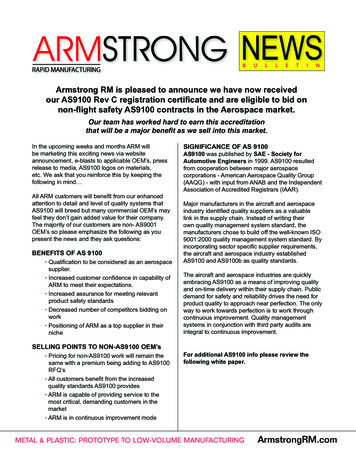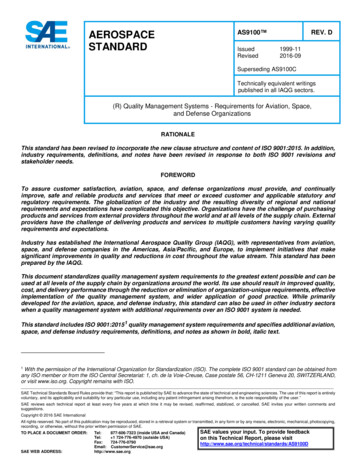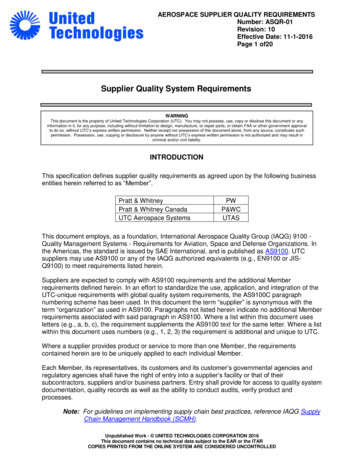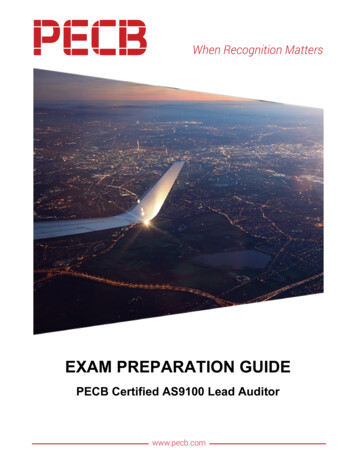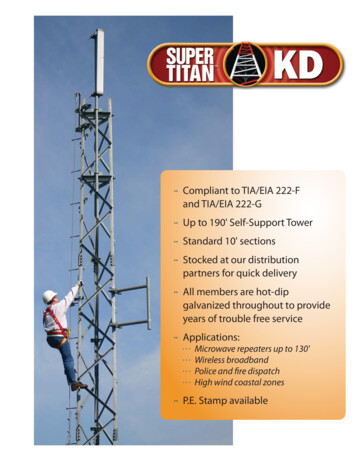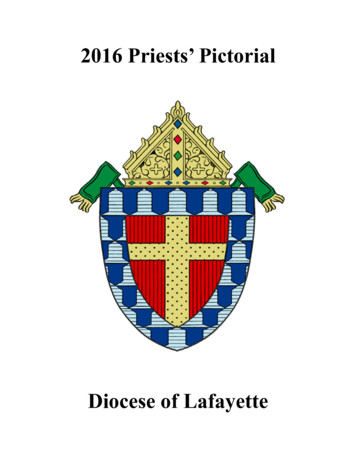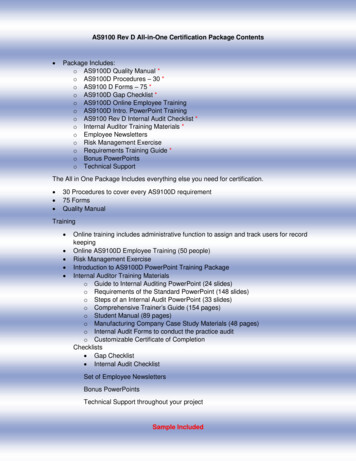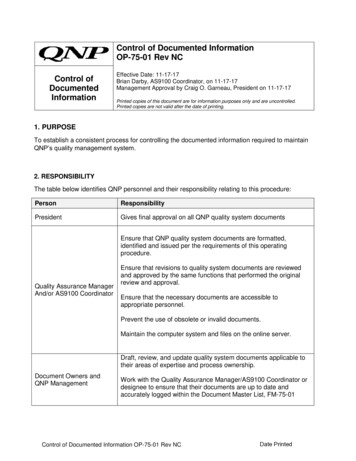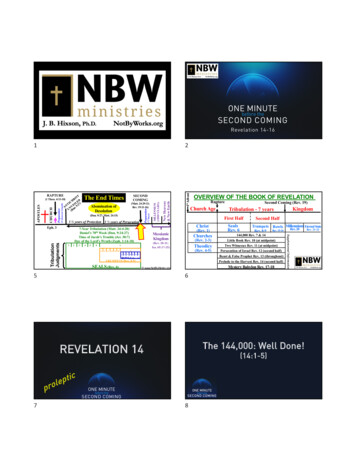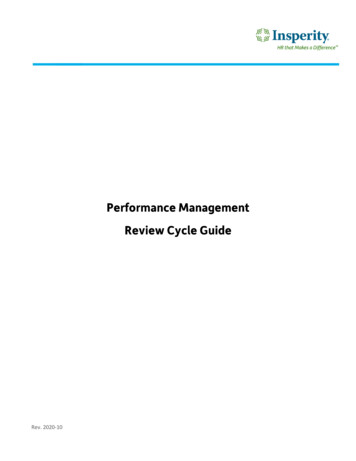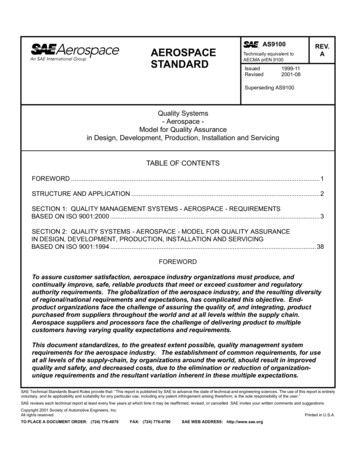
Transcription
AEROSPACESTANDARDAS9100Technically equivalent toAECMA prEN 9100IssuedRevisedREV.A1999-112001-08Superseding AS9100Quality Systems- Aerospace Model for Quality Assurancein Design, Development, Production, Installation and ServicingTABLE OF CONTENTSFOREWORD .1STRUCTURE AND APPLICATION .2SECTION 1: QUALITY MANAGEMENT SYSTEMS - AEROSPACE - REQUIREMENTSBASED ON ISO 9001:2000 .3SECTION 2: QUALITY SYSTEMS - AEROSPACE - MODEL FOR QUALITY ASSURANCEIN DESIGN, DEVELOPMENT, PRODUCTION, INSTALLATION AND SERVICINGBASED ON ISO 9001:1994 .38FOREWORDTo assure customer satisfaction, aerospace industry organizations must produce, andcontinually improve, safe, reliable products that meet or exceed customer and regulatoryauthority requirements. The globalization of the aerospace industry, and the resulting diversityof regional/national requirements and expectations, has complicated this objective. Endproduct organizations face the challenge of assuring the quality of, and integrating, productpurchased from suppliers throughout the world and at all levels within the supply chain.Aerospace suppliers and processors face the challenge of delivering product to multiplecustomers having varying quality expectations and requirements.This document standardizes, to the greatest extent possible, quality management systemrequirements for the aerospace industry. The establishment of common requirements, for useat all levels of the supply-chain, by organizations around the world, should result in improvedquality and safety, and decreased costs, due to the elimination or reduction of organizationunique requirements and the resultant variation inherent in these multiple expectations.SAE Technical Standards Board Rules provide that: “This report is published by SAE to advance the state of technical and engineering sciences. The use of this report is entirelyvoluntary, and its applicability and suitability for any particular use, including any patent infringement arising therefrom, is the sole responsibility of the user.”SAE reviews each technical report at least every five years at which time it may be reaffirmed, revised, or cancelled. SAE invites your written comments and suggestions.Copyright 2001 Society of Automotive Engineers, Inc.All rights reserved.TO PLACE A DOCUMENT ORDER: (724) 776-4970Printed in U.S.A.FAX: (724) 776-0790SAE WEB ADDRESS: http://www.sae.org
SAEAS9100Revision ASTRUCTURE AND APPLICATIONThis standard includes aerospace requirements applied to, and integrated with, both the ISO 9001:2000and the ISO 9001:1994 quality management system models. The section of this standard that shall applyis determined by the organization’s current quality management system (QMS) status in regards toalignment/compliance with ISO 9001.Organizations now having a QMS based on ISO 9001:1994, that are expanding the scope of their QMS toinclude AS9100 requirements, shall utilize the section of this standard aligned with ISO 9001:1994. Upontransition to an ISO 9001:2000-based QMS, organizations shall use the section of this standard alignedwith ISO 9001:2000. In accordance with the time period established for organizations to transition fromISO 9001:1994 to ISO 9001:2000, the section of this standard based on the ISO 9001:1994 model will bewithdrawn on December 15, 2003.Organizations initially developing an ISO 9001/AS9100-based QMS after December 15, 2000 mustdevelop a QMS based on ISO 9001:2000 and shall utilize the section of this standard that is based on ISO9001:2000.The ISO 9001 model, and the corresponding AS9100 section, that is deployed shall be declared in theorganization’s quality manual.-2-
SAEAS9100Revision ASECTION 1 - QUALITY MANAGEMENT SYSTEMS - AEROSPACE - REQUIREMENTSBASED ON ISO 9001:2000TABLE OF CONTENTSINTRODUCTION .61. SCOPE .81.11.2General .8Application .82. NORMATIVE REFERENCE.93. TERMS AND DEFINITIONS .94. QUALITY MANAGEMENT SYSTEM .104.14.24.2.14.2.24.2.34.2.44.3General Requirements .10Documentation Requirements.11General . 11Quality Manual . 11Control of Documents .12Control of Records .12Configuration Management.125. MANAGEMENT .25.5.35.65.6.15.6.25.6.3Management Commitment.13Customer Focus.13Quality Policy .13Planning .13Quality Objectives .13Quality Management System Planning.14Responsibility, Authority and Communication .14Responsibility and Authority.14Management Representative .14Internal Communication .14Management Review .14General .14Review Input .15Review Output .15-3-
SAEAS9100Revision ATABLE OF CONTENTS (Continued)6. RESOURCE MANAGEMENT.156.16.26.2.16.2.26.36.4Provision of Resources .15Human Resources .15General .15Competence, Awareness and Training .15Infrastructure.16Work Environment.167. PRODUCT .5.27.5.37.5.47.5.57.6Planning of Product Realization.16Customer-Related Processes .17Determination of Requirements Related to the Product.17Review of Requirements Related to the Product .17Customer Communication .17Design and Development.18Design and Development Planning.18Design and Development Inputs .18Design and Development Outputs .19Design and Development Review.19Design and Development Verification .20Design and Development Validation .20Control of Design and Development Changes.21Purchasing .22Purchasing Process .22Purchasing Information .23Verification of Purchased Product.24Production and Service Provision .25Control of Production and Service Provision .25Validation of Processes for Production and Service Provision.27Identification and Traceability.28Customer Property.28Preservation of Product .29Control of Monitoring and Measuring Devices .298. MEASUREMENT, ANALYSIS AND IMPROVEMENT.308.18.28.2.18.2.28.2.38.2.4General .30Monitoring and Measurement .31Customer Satisfaction.31Internal Audit.31Monitoriing and Measurement of Processes.32Monitoring and Measurement of Product.32-4-
SAEAS9100Revision ATABLE OF CONTENTS (Continued)8.38.48.58.5.18.5.28.5.3Control of Nonconforming Product.33Analysis of Data .35Improvement .35Continual Improvement.35Corrective Action.35Preventive Action .36ANNEX ABibliography .37-5-
SAEAS9100Revision AINTRODUCTIONGeneral:The adoption of a quality management system should be a strategic decision of an organization. Thedesign and implementation of an organization’s quality management system is influenced by varyingneeds, particular objectives, the products provided, the processes employed and the size and structure ofthe organization. It is not the intent of this International Standard to imply uniformity in the structure ofquality management systems or uniformity of documentation.The quality management system requirements specified in this International Standard are complementaryto requirements for products. Information marked "NOTE" is for guidance in understanding or clarifyingthe associated requirement.This International Standard can be used by internal and external parties, including certification bodies, toassess the organization’s ability to meet customer, regulatory and the organization’s own requirements.The quality management principles stated in ISO 9000 and ISO 9004 have been taken into considerationduring the development of this International Standard.Process Approach:This International Standard promotes the adoption of a process approach when developing, implementingand improving the effectiveness of a quality management system, to enhance customer satisfaction bymeeting customer requirements.For an organization to function effectively, it has to identify and manage numerous linked activities. Anactivity using resources, and managed in order to enable the transformation of inputs into outputs, can beconsidered as a process. Often the output from one process directly forms the input to the next.The application of a system of processes within an organization, together with the identification andinteractions of these processes, and their management, can be referred to as the "process approach".An advantage of the process approach is the ongoing control that it provides over the linkage between theindividual processes within the system of processes, as well as over their combination and interaction.When used within a quality management system, such an approach emphasizes the importance of:a.b.c.d.understanding and meeting requirements,the need to consider processes in terms of added value,obtaining results of process performance and effectiveness, andcontinual improvement of processes based on objective measurement.-6-
SAEAS9100Revision AThe model of a process-based quality management system shown in Figure 1 illustrates the processlinkages presented in clauses 4 to 8. This illustration shows that customers play a significant role indefining requirements as inputs. Monitoring of customer satisfaction requires the evaluation of informationrelating to customer perception as to whether the organization has met the customer requirements. Themodel shown in Figure 1 covers all the requirements of this International Standard, but does not showprocesses at a detailed level.NOTE: In addition, the methodology known as "Plan-Do-Check-Act" (PDCA) can be applied to allprocesses. PDCA can be briefly described as follows:Plan:establish theh objectives and processes necessary to deliver results in accordance withcustomer requirements and the organization’s policies.Do:implement the processes.Check: monitor and measure processes and product against policies, objectives and requirements forthe product and report the results.Act:take actions to continually improve process performance.FIGURE 1 - Model of a Process-Based Quality Management System-7-
SAEAS9100Revision A1. SCOPE:1.1General:This standard includes ISO 9001:20001 quality management system requirements andspecifies additional requirements for a quality management system for the aerospaceindustry. The additional aerospace requirements are shown in bold, italic text.It is emphasized that the quality management system requirements specified in this standardare complementary (not alternative) to contractual and applicable law and regulatoryrequirements.This International Standard specifies requirements for a quality management system where anorganizationa. needs to demonstrate its ability to consistently provide product that meets customer andapplicable regulatory requirements, andb. aims to enhance customer satisfaction through the effective application of the system, includingprocesses for continual improvement of the system and the assurance of conformity to customerand applicable regulatory requirements.NOTE In this International Standard, the term “product” applies only to the product intended for, orrequired by, a customer.1.2Application:All requirements of this International Standard are generic and are intended to be applicable to allorganizations, regardless of type, size and product provided.Where any requirement(s) of this International Standard cannot be applied due to the nature of anorganization and its product, this can be considered for exclusion.Where exclusions are made, claims of conformity to this International Standard are not acceptableunless these exclusions are limited to requirements within clause 7, and such exclusions do notaffect the organization's ability, or responsibility, to provide product that meets customer andapplicable regulatory requirements.1With the permission of the International Organization for Standardization (ISO). The complete standard may be obtained from any ISO memberor from the ISO Central Secretariat, Case Postale 56, 1211 Geneva 20, SWITZERLAND. Copyright remains with ISO.-8-
SAEAS9100Revision A2. NORMATIVE REFERENCE:The following normative document contains provisions which, through reference in this text, constituteprovisions of this International Standard. For dated references, subsequent amendments to, orrevisions of, any of these publications do not apply. However, parties to agreements based on thisInternational Standard are encouraged to investigate the possibility of applying the most recent editionof the normative document indicated below. For undated references, the latest edition of the normativedocument referred to applies. Members of ISO (International Organization for Standardization) andIEC (International Electrotechnical Commission) maintain registers of currently valid InternationalStandards.ISO 9000:2000, Quality management systems - Fundamentals and vocabulary.3. TERMS AND DEFINITIONS:For the purposes of this International Standard, the terms and definitions given in ISO 9000 apply.The following terms, used in this edition of ISO 9001 to describe the supply chain, have been changedto reflect the vocabulary currently used:supplier organization customerThe term “organization” replaces the term “supplier” used in ISO 9001:1994, and refers to the unit towhich this International Standard applies. Also, the term “supplier” now replaces the term“subcontractor”.Throughout the text of this International Standard, wherever the term “product” occurs, it can alsomean “service”.Key Characteristics: The features of a material, process, or part whose variation has asignificant influence on product fit, performance, service life, or manufacturability.-9-
SAEAS9100Revision A4. QUALITY MANAGEMENT SYSTEM:4.1General Requirements:The organization shall establish, document, implement and maintain a quality management systemand continually improve its effectiveness in accordance with the requirements of this InternationalStandard.The organization shalla. identify the processes needed for the quality management system and their applicationthroughout the organization (see 1.2),b. determine the sequence and interaction of these processes,c. determine criteria and methods needed to ensure that both the operation and control of theseprocesses are effective,d. ensure the availability of resources and information necessary to support the operation andmonitoring of these processes,e. monitor, measure and analyse these processes, andf.implement actions necessary to achieve planned results and continual improvement of theseprocesses.These processes shall be managed by the organization in accordance with the requirements of thisInternational Standard.Where an organization chooses to outsource any process that affects product conformity withrequirements, the organization shall ensure control over such processes. Control of suchoutsourced processes shall be identified within the quality management system.NOTE Processes needed for the quality management system referred to above should includeprocesses for management activities, provision of resources, product realization and measurement.- 10 -
SAE4.24.2.1AS9100Revision ADocumentation Requirements:General: The quality management system documentation shall includea. documented statements of a quality policy and quality objectives,b. a quality manual,c. documented procedures required by this International Standard,d. documents needed by the organization to ensure the effective planning, operation and controlof its processes,e. records required by this International Standard (see 4.2.4), andf.quality system requirements imposed by the applicable regulatory authorities.The organization shall ensure that personnel have access to quality management systemdocumentation and are aware of relevant procedures. Customer and/or regulatoryauthorities representatives shall have access to quality management systemdocumentation.NOTE 1 Where the term “documented procedure” appears within this International Standard, thismeans that the procedure is established, documented, implemented and maintained.NOTE 2 The extent of the quality management system documentation can differ from oneorganization to another due toa. the size of organization and type of activities,b. the complexity of processes and their interactions, andc. the competence of personnel.NOTE 3 The documentation can be in any form or type of medium.4.2.2Quality Manual: The organization shall establish and maintain a quality manual that includesa. the scope of the quality management system, including details of and justification for anyexclusions (see 1.2),b. the documented procedures established for the quality management system, or reference tothem, and- when referencing the documented procedures, the relationship between therequirements of this International Standard and the documented procedures shall beclearly shown.c. a description of the interaction between the processes of the quality management system.- 11 -
SAE4.2.3AS9100Revision AControl of Documents: Documents required by the quality management system shall becontrolled. Records are a special type of document and shall be controlled according to therequirements given in 4.2.4.A documented procedure shall be established to define the controls neededa. to approve documents for adequacy prior to issue,b. to review and update as necessary and re-approve documents,c. to ensure that changes and the current revision status of documents are identified,d. to ensure that relevant versions of applicable documents are available at points of use,e. to ensure that documents remain legible and readily identifiable,f.to ensure that documents of external origin are identified and their distribution controlled, andg. to prevent the unintended use of obsolete documents, and to apply suitable identification tothem if they are retained for any purpose.The organization shall coordinate document changes with customers and/or regulatoryauthorities in accordance with contract or regulatory requirements.4.2.4Control of Records: Records shall be established and maintained to provide evidence ofconformity to requirements and of the effective operation of the quality management system.Records shall remain legible, readily identifiable and retrievable. A documented procedure shallbe established to define the controls needed for the identification, storage, protection, retrieval,retention time and disposition of records.The documented procedure shall define the method for controlling records that are createdby and/or retained by suppliers.Records shall be available for review by customers and regulatory authorities inaccordance with contract or regulatory requirements.4.3Configuration Management:The organization shall establish, document and maintain a configuration managementprocess appropriate to the product.NOTE Guidance on configuration management is given in ISO 10007.- 12 -
SAEAS9100Revision A5. MANAGEMENT RESPONSIBILITY:5.1Management Commitment:Top management shall provide evidence of its commitment to the development and implementationof the quality management system and continually improving its effectiveness bya. communicating to the organization the importance of meeting customer as well as statutory andregulatory requirements,b. establishing the quality policy,c. ensuring that quality objectives are established,d. conducting management reviews, ande. ensuring the availability of resources.5.2Customer Focus:Top management shall ensure that customer requirements are determined and are met with the aimof enhancing customer satisfaction (see 7.2.1 and 8.2.1).5.3Quality Policy:Top management shall ensure that the quality policya. is appropriate to the purpose of the organization,b. includes a commitment to comply with requirements and continually improve the effectiveness ofthe quality management system,c. provides a framework for establishing and reviewing quality objectives,d. is communicated and understood within the organization, ande. is reviewed for continuing suitability.5.45.4.1Planning:Quality Objectives: Top management shall ensure that quality objectives, including those neededto meet requirements for product [see 7.1 a)], are established at relevant functions and levelswithin the organization. The quality objectives shall be measurable and consistent with the qualitypolicy.- 13 -
SAE5.4.2AS9100Revision AQuality Management System Planning: Top management shall ensure thata. the planning of the quality management system is carried out in order to meet the requirementsgiven in 4.1, as well as the quality objectives, andb. the integrity of the quality management system is maintained when changes to the qualitymanagement system are planned and implemented.5.5Responsibility, Authority and Communication:5.5.1Responsibility and Authority: Top management shall ensure that the responsibilities andauthorities are defined and communicated within the organization.5.5.2Management Representative: Top management shall appoint a member of management who,irrespective of other responsibilities, shall have responsibility and authority that includesa. ensuring that processes needed for the quality management system are established,implemented and maintained,b. reporting to top management on the performance of the quality management system and anyneed for improvement,c. ensuring the promotion of awareness of customer requirements throughout the organization,andd. the organizational freedom to resolve matters pertaining to quality.NOTE The responsibility of a management representative can include liaison with external partieson matters relating to the quality management system.5.5.35.65.6.1Internal Communication: Top management shall ensure that appropriate communicationprocesses are established within the organization and that communication takes place regardingthe effectiveness of the quality
Organizations initially developing an ISO 9001/AS9100-based QMS after December 15, 2000 must develop a QMS based on ISO 9001:2000 and shall utilize the section of this standard that is based on ISO 9001:2000. The ISO 9001 model, and the corresponding AS9100 section, that is deployed shall be declared in the organization's quality manual.
